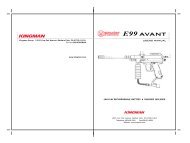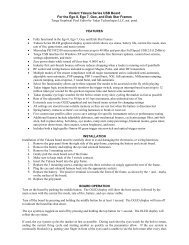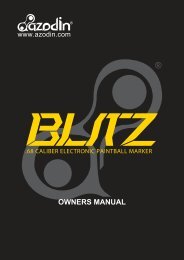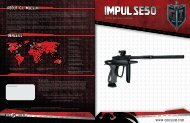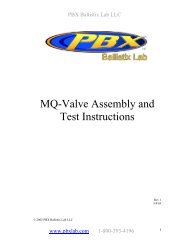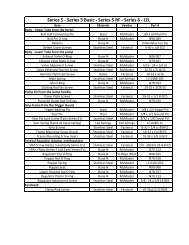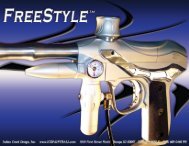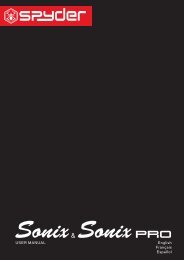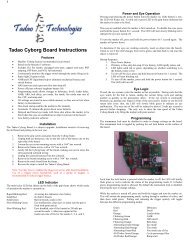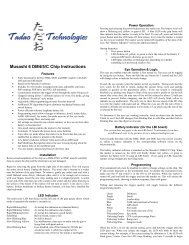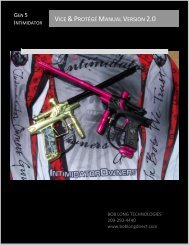Etek Ego Board Instructions - Tadao Technologies
Etek Ego Board Instructions - Tadao Technologies
Etek Ego Board Instructions - Tadao Technologies
You also want an ePaper? Increase the reach of your titles
YUMPU automatically turns print PDFs into web optimized ePapers that Google loves.
SettingsDebounce – The <strong>Tadao</strong> <strong>Etek</strong> <strong>Ego</strong> board features an interrupt based debounce algorithmthat effectively “scans” the trigger over 2 million times per second. It runs thiscompletely independent of code execution on the microcontroller so your trigger pullsare always registered. The debounce setting is in increments of 1/2 milliseconds. Usersshould be aware that low debounce settings may cause the marker to read switch bounceas additional pulls, falsely generating shots or near full-automatic fire. The settingranges from 1 to 50 and is defaulted at 10 (5 ms).Dwell – The amount of time the solenoid is energized each time the marker is fired. Thedefault is 12 ms. The range is 2 to 20 ms. Too low of a dwell may lead to inconsistencyor drop-off. Too high of a dwell can cause bad air efficiency.Loader delay – Adds a slight delay after the eye has seen a ball and the bolt is cycled,causing the gun to fire. If not using force fed loaders, it may be necessary to increasethis setting to prevent chopping. A setting of 1 means no loader delay, which is thefastest. The default is 2 and may be set from 1 to 25.AMB (Anti-mechanical bounce) – Allows the user to adjust the anti-mechanicalbounce feature. Mechanical bounce occurs due to the kick generated during each shotand can cause the marker to “run away” on the first few shots. AMB helps stop markersfrom going full-auto when the trigger is pulled very slowly. The default is 2 and may beset from 1 to 5 (1 being off). AMB is only used in fire modes 1 and 2 (semi-automaticunlimited and adjustable).ABS dwell – Amount of dwell time added for an ABS (anti-bolt stick) shot. The rangeis from 1 to 10 additional milliseconds of dwell. The default is 1, which is disabled.ABS programming helps to eliminate first shot drop-off. First shot drop-off occurs whenthe lube and o-rings settle or “stick” inside the marker after it has been sitting. The nextshot fired will be lower in velocity because the bolt has to break free. ABS will slightlyincrease the dwell to compensate if the marker is left sitting for 15 seconds.Fire mode – Included are 12 different fire modes (default is 1):1. Semi-automatic, unlimited rate of fire2. Semi-automatic, adjustable rate of fire3. PSP auto-response4. PSP 50% ramping, adjustable ramp start5. PSP 100% ramping, adjustable ramp start6. PSP burst7. NXL full-automatic8. Auto-response9. 50% ramping10. 100% ramping11. 3 round burst12. Full-automaticSetting 1 is normal semi-automatic with an unlimited rate of fire while the eyes areenabled. When the eyes are turned off, the max rate of fire is set to 20 balls per second.Setting 2 is semi-automatic with an adjustable rate of fire. It limits the maximum ballsper second that can be fired. The cap is set by the max rate of fire setting.Setting 3 is the PSP auto-response fire mode that works as follows:• The first 3 shots of a string are semi-automatic• After the 4th shot the marker will fire on the pull and release in autoresponsemode• If the user stops firing for more than 1 second, the 3-shot semi-automaticcount starts overSetting 4 is the PSP 50% ramping fire mode that works as follows:• The first 3 shots of a string are semi-automatic• After the 4th shot the marker will ramp, adding 1 additional shot for every 2pulled by the user, as long as the user pulls the trigger faster than the rampstart setting• If the user stops firing for more than 1 second, the 3-shot semi-automaticcount starts overSetting 5 is the PSP 100% ramping fire mode that works as follows:• The first 3 shots of a string are semi-automatic• After the 4th shot the marker will ramp up to the loader’s maximum speed orthe maximum rate of fire, as long as the user pulls the trigger faster than theramp start setting• If the user stops firing for more than 1 second, the 3-shot semi-automaticcount starts overSetting 6 is the PSP burst fire mode that works as follows:• The first 3 shots of a string are semi-automatic• After the 4th shot the marker will burst fire 3 shots per pull• If the user stops firing for more than 1 second, the 3-shot semi-automaticcount starts overSetting 7 is the NXL full-automatic fire mode. It functions similarly to the PSP firemodes except, after the 3rd semi-automatic shot, the user may pull and hold the triggerfor the marker to fire in full-automatic.Setting 8 is the normal auto-response fire mode. The marker will fire on each pull andrelease of the trigger, generating 2 shots per full pull cycle.Setting 9 is the normal 50% ramping fire mode. The marker will fire in semi-automaticunless the user pulls the trigger faster than the ramp start setting. Once the ramp startsetting has been achieved, the marker will 50% ramp, adding 1 additional shot for every2 trigger pulls.Setting 10 is the normal 100% ramping fire mode. The marker will fire in semiautomaticunless the user pulls the trigger faster than the ramp start setting. Once theramp start setting has been achieved, the marker will ramp up to the maximum feed rateof the loader or the maximum rate of fire setting, whichever is lower.Setting 11 is the normal 3 round burst fire mode. The marker will burst fire 3 times forevery pull and release of the trigger.Setting 12 is the normal full-automatic fire mode. As long as the trigger is depressed themarker will fire in full-automatic.Fire mode max rate of fire – The max rate of fire setting applies to the 2nd – 12th firemodes. The max rate of fire is adjustable from 14 to 20 balls per second in 1/4 balls persecond increments, and has an unlimited setting for maxing out the loader system. Thedefault is 4, which is roughly 14.75 balls per second. Oscillator inconsistencies fromchip to chip make it impossible to time perfectly, so the only true way to check rate offire is to use a Pact Timer or ballistic chronograph. The red radar chronographscommonly found at fields are NOT reliable.Setting BPS Setting BPS Setting BPS1 14.0 9 16.0 17 18.02 14.25 10 16.25 18 18.253 14.5 11 16.5 19 18.54 14.75 12 16.75 20 18.755 15.0 13 17.0 21 19.06 15.25 14 17.25 22 19.257 15.5 15 17.5 23 19.58 15.75 16 17.75 24 19.7525 20.026 Unlimited eyes on20 bps eyes offEye Mode – Four eye modes are available:1. Delayed – If the eye system does not detect a ball in the breech for 1/2 second, themarker automatically fires. This is useful for sound activated loaders because itensures that a shot is fired, even without paint, so the loader will continue to feed.2. Forced with force shot – The marker only fires if paint is seen in the breech or theuser pulls and holds the trigger for 1/2 second, thereby initiating a force shot.3. Test – This mode is specifically for seeing how fast the user can fire the marker, orhow fast the pneumatics can actually cycle. The eyes work to prevent firing ifthey are blocked. This mode is only for dry firing. The LED is used to show thefastest achieved rate of fire:Red less than 10 bpsYellow between 10 and 15 bpsGreen between 15 and 20 bpsBlue between 20 and 25 bpsWhite 25 bps or greaterAs long as the user continues to fire, the fastest achieved rate of fire will continueto be displayed on the LED. If the user stops firing for 1 second, the LED willcycle back through the rate of fire colors.4. Training – This mode works just like the test eye mode, but features an adjustabledwell setting independent of the normal dwell, which makes it easy for users toadjust their trigger settings and try them out with much less noise and airconsumption. The training mode dwell setting corresponds with this eye mode.




